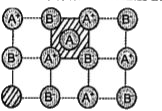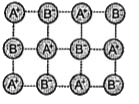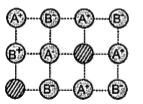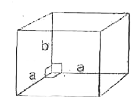The type of seciconductor shown by crystal capable of showing Schotlky defect, will be.
p-type
n-type
both
None
The correct Answer is:A
To determine the type of semiconductor that can exhibit Schottky defects, we can follow these steps:
Step 1: Understand the Types of Semiconductors
- P-type Semiconductors: These semiconductors have an abundance of holes (positive charge carriers) compared to electrons (negative charge carriers). They are formed by doping a semiconductor material (like silicon) with elements that have fewer valence electrons (like boron).
- N-type Semiconductors: These have more electrons than holes. They are formed by doping with elements that have more valence electrons (like phosphorus).
Step 2: Define Schottky Defect
- A Schottky defect is a type of point defect in a crystal lattice where an equal number of cations and anions are missing from their lattice sites. This defect leads to vacancies in the crystal structure.
Step 3: Analyze the Relationship Between Schottky Defect and Semiconductors
- In p-type semiconductors, the presence of holes (vacancies where electrons are missing) allows for the formation of Schottky defects. The removal of cations and anions creates these vacancies, which are similar to the holes in p-type semiconductors.
Step 4: Conclusion
- Since Schottky defects are associated with the presence of vacancies (holes) in the crystal lattice, and p-type semiconductors inherently have more holes than electrons, it can be concluded that the type of semiconductor capable of showing Schottky defects is p-type semiconductor.
Final Answer
The type of semiconductor shown by a crystal capable of showing Schottky defect is p-type semiconductor.
---
- P-type Semiconductors: These semiconductors have an abundance of holes (positive charge carriers) compared to electrons (negative charge carriers). They are formed by doping a semiconductor material (like silicon) with elements that have fewer valence electrons (like boron).
- N-type Semiconductors: These have more electrons than holes. They are formed by doping with elements that have more valence electrons (like phosphorus).
- A Schottky defect is a type of point defect in a crystal lattice where an equal number of cations and anions are missing from their lattice sites. This defect leads to vacancies in the crystal structure.
- In p-type semiconductors, the presence of holes (vacancies where electrons are missing) allows for the formation of Schottky defects. The removal of cations and anions creates these vacancies, which are similar to the holes in p-type semiconductors.
- Since Schottky defects are associated with the presence of vacancies (holes) in the crystal lattice, and p-type semiconductors inherently have more holes than electrons, it can be concluded that the type of semiconductor capable of showing Schottky defects is p-type semiconductor.
The type of semiconductor shown by a crystal capable of showing Schottky defect is p-type semiconductor.
Topper's Solved these Questions
Similar Questions
Knowledge Check
- Question 1 - Select One
The crystal showing Frenkel defect is:
A B
B C
C D
D
- Question 2 - Select One
Which of the following point defects are shown by AgBr (s) crystals ?
(a) Schottky defect
(b) Frenkel defect
( c) metal ecxess defect
(d) Metal deficiency defectA(I) and (II)B(II) and (IV)C(I) and (III)D(II) and (IV) - Question 3 - Select One
Which of the following point defects are shown by AgBr(s) crystals ?
(A) Schottky defect (B) Frenkel defect
(C) Metal excess defect (D) Metal deficiency defect.A(A) and (B)B(C) and (D)C(A) and (C)D(B) and (D)
Identify the incorrect statement regarding a crystal showing Schottky defect?
View SolutionWhat type of stoichiometric defect is shown by NaCl ? Explain.
View SolutionWhat type of stoichiometric defect is shown by AgCl ?
View Solutionwhich of the following point defects are shoen by AgBr (s) crystals ?
(a) Schottky defect
(b) Frenkel defect
( c) metal ecxess defect
(d) Metal deficiency defectView SolutionWhat type of stoichiometric defect is shown by AgCl?
View Solution


